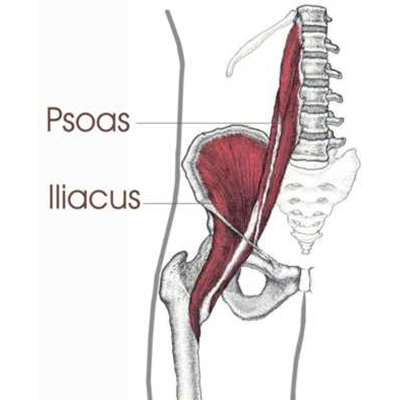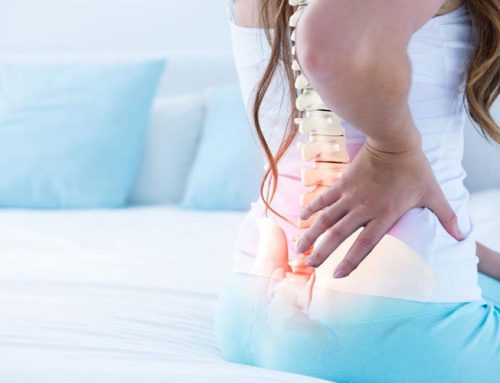Many of us have been there: we wake up in the morning with severe low back pain or stiffness that came out of nowhere. Could you be suffering from Iliopsoas Syndrome? Nothing we did the day before seems to be out of the ordinary, and yet, today we can barely move without some major discomfort. There are many reasons for Low Back Pain, but if your Low Back Pain is accompanied by pain in the following areas:
- Lower abdomen
- Groin
- Buttocks
- Down the leg
- Hip
- Lower back
- Sacroiliac joint
- Across the top of the hip bone (iliac crest),
then the culprit may be a problem in a hip flexor muscle, called Iliopsoas. The iliopsoas is actually comprised of two muscles: the psoas muscle and the iliacus muscle.

The psoas major muscle is unique in that it originates in the upper body, attaching along the lumbar spine and intervertebral discs, then crosses over to the lower body to attach at the upper inner thigh bone (lesser trochanter of the femur).
The iliacus muscle attaches to the upper two-thirds of the iliac fossa then descends to join the psoas major tendon, with some of its fibers attaching directly to the femur near the lesser trochanter.
When these two muscles contract, the hip flexes, as in lifting the knee to take a step when walking. Additionally; due to its attachment along the lumbar spine, the psoas plays a major role in maintaining upright posture.
Dysfunction of the iliopsoas — commonly referred to as Iliopsoas Syndrome — is responsible for more unexplained back, hip and leg pain than any other single cause. The most common cause is sitting for long periods of time, which will place the muscle in a state of chronic contraction, which can have some very undesirable outcomes:
Trigger Points: A chronically contracted muscle can develop trigger points which refer pain (or numerous other sensations, such as tingling, numbness or aching) to other parts of the body.
Nerve Entrapment: A chronically contracted muscle may be responsible for entrapment of nerves, another cause of pain. In the case of the iliopsoas, entrapment of the following nerves is possible: the femoral nerve, the lateral femoral cutaneous nerve, the femoral branch of the genitofemoral nerves, the iliohypogastric nerve and the ilioinguinal nerve. This may explain pain and numbness felt in the groin, lower abdomen, or front of the hip.
Muscular Compensation: A chronically contracted muscle can cause other compensations or distortions in the body. If a chronically tight iliacus, for example, reduces movement in one hip, then the other hip or the spine or other parts of the body will be called upon to compensate or to change their normal pattern of movement. This will lead to pain and stiffness in areas other than the hip flexors. Thus, a dysfunctional iliopsoas muscle on the right side of the body, for example, could result in pain on the left side of the body. The left side might be getting severely overworked.
Treating Painful Hip Flexor Syndrome or Iliopsoas Syndrome
Gentle Stretching: Stretching can help elongate a shortened iliopsoas muscle. The following stretching exercise may be helpful in alleviating some of the hip flexor tightness. The stretch should be held for up to a minute on each side. Additionally; a gentle and slow rocking motion forward and backward on the kneeling knee will help activate the iliopsoas muscle for a more successful stretch. It may be helpful to place a folded towel under the knee on the ground in order to protect it during therapy.

Heating Pad: Apply heat therapy to the painful areas, such as low back and lower abdomen to relieve muscle tension and promote relaxation.
Final Thoughts Regarding Ilopsoas Syndrome
Final Thoughts: Though stretching can help elongate a shortened iliopsoas, due to the deep-seated location of the muscle, it may be very difficult to isolate and self-treat. For best outcome, stretching should be preceded by manual trigger point therapy done by a health care practitioner. Therefore; if pain and discomfort persist for more than a couple of days, seek professional help. Chiropractic and Physiotherapy are very effective in treatment of musculoskeletal problems, such as Iliopsoas Syndrome.





